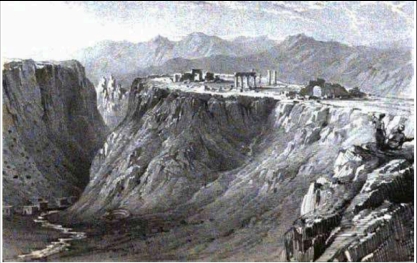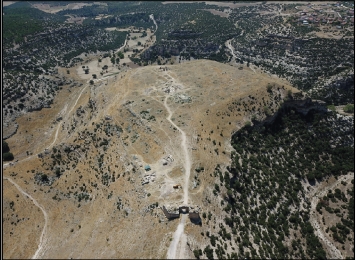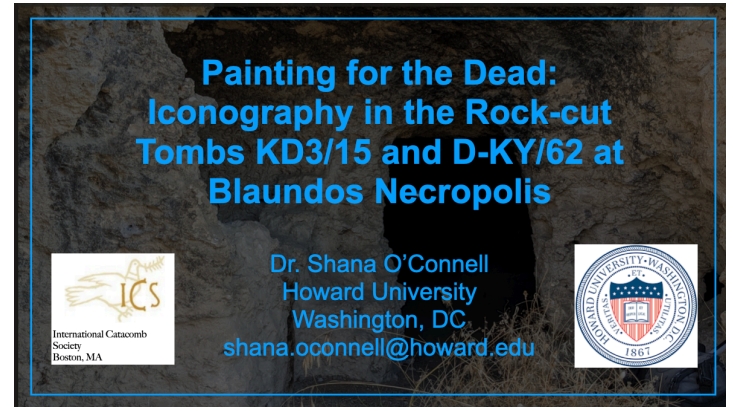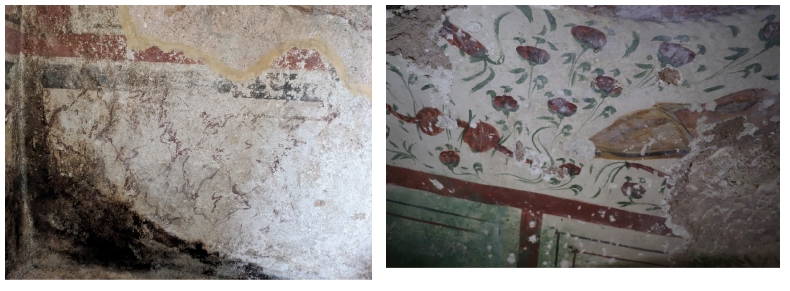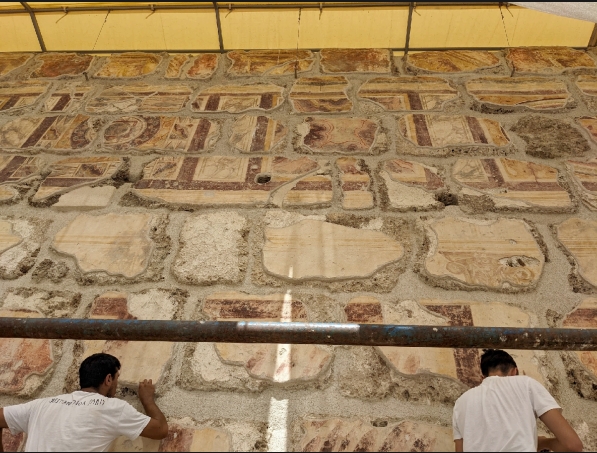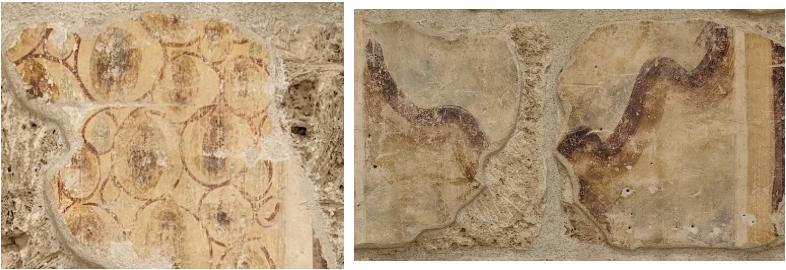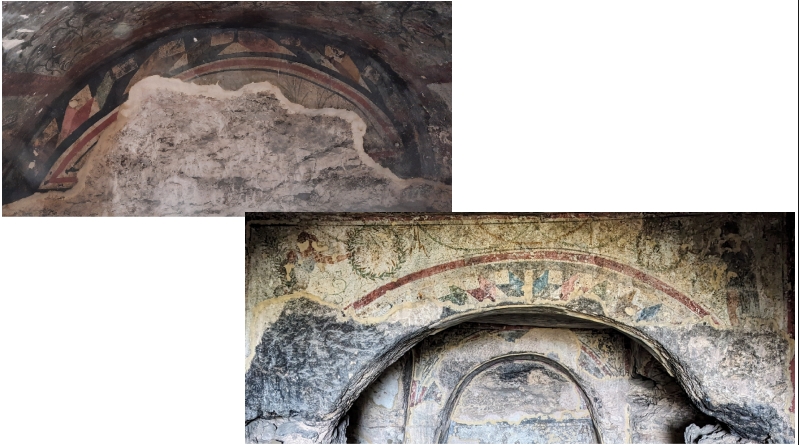Inside of around thirty rock-cut tombs dating from the 2nd century - 4th century AD are wall paintings made for residents of the ancient city of Blaundos (Ulubey/Uşak, Turkey). This city was first established as a Macedonian colony on a hill surrounded by valleys. From the outset, wealthy residents had tombs cut into the rock of surrounding bluffs. By the Roman period (1st century AD), Blaundos was a well-appointed city with aqueducts, a marble colonnade, two temples, a gymnasium, and theater (Figure 1-2).
Residents continued to be buried in the necropoleis and the entrances to their tombs were visible from the city. At present, the site has been surveyed (Filges 2006) and a few of the tombs and city center have been excavated (Can 2017).
About 400 tombs were cut into the bluffs of the valley surrounding the city (Figure 3). Preserved in thirty of these tombs, there are wall paintings which depict garlands, grapevines, roses, birds, gorgons, Hermes, and Aphrodite and her erotes. The paintings date to the 2nd-3rd centuries CE, after the Blaundos was under Roman administration. The aim of my project is to publish the iconography of the tomb paintings and report on the pigments and techniques of artists. The paintings are images created for the deceased and the maintenance of their cult in perpetuity; they are a remarkable body of evidence that enriches our understanding of Blaundos, ancient painting in Western Turkey, and visual culture in a funerary context.
Starting on July 8, 2023I I visited Izmir Province, where Blaundos is located, for one month. For most of this period I worked with the research team led by Dr. Birol Can (Uşak Üniversitesi). Additionally, I visited archaeological sites at Ephesos, Laodicea, and Hieropolis and presented a paper at the Blaundos Çalışmayı held at the Uşak Arkeoloji Müzesi on August 2, 2023 (Figure 11).
Painting at Blaundos, Ephesos, and Laodicea
Each of my visits to sites in Izmir yielded comparative material for the rock-cut tomb paintings at Blaundos. At Ephesos, wall paintings in elite houses were similar to those at Blaundos in terms of style and dating. At Laodicea, public wall paintings made in a more illusionistic style demonstrate the variation of the regional tradition and its similarity to the well-documented 1st century BC - 1st century AD wall painting at Pompeii.
There are several more tombs in Turkey, Bulgaria, and Syria respectively which feature geometric motifs similar to ones found in the paintings at Blaundos. These geometric motifs are also ubiquitous in floor mosaics; their presence in the paintings shows the adaptation of motifs across media. In the future, I will revisit sites in Izmir and travel to the accessible sites with comparable tomb paintings.
At Ephesos, Terrace House 2 features wall paintings dating after AD 270. (Pottery from the excavated tombs at Blaundos provides a terminus ante quem of the 3rd century AD; On 1 Terrace House 2: Ladstätter 2012.)
The monochrome and non-figural 1 motifs in the paintings at Ephesos are similar to those painted in several tombs at Blaundos (Figures 4-5). At both sites, painters used dark red borders of varying line weights to organize motifs and divide the wall surface. Such borders have parallels in Late Roman wall painting (Ling 1991).

Figure 4. Wall paintings depicting imitation marble, fields of flowers, and a garland, from Terrace House 2 at Ephesos in situ
Other motifs from Ephesos and Blaundos include 2 imitation marble, red flowers, ribbons, and garlands. The dating of the paintings at both sites and their similar style suggests that they were part of a regional tradition. This regional tradition has not yet been systematically studied. Close examination of painting from both sites could indicate they were painted by the same artists.
In the agora at of the ancient city of Laodicea, near Denizli, there is a massive reconstructed painted wall in a portico (Figure 6-7). This wall depicts several courses of imitation marble masonry, geometric motifs, and Corinthian-style columns. The painted columns mirrored actual ones in the peristyle in front of them. The polychromy and level of detail a Laodicea is quite different from that of the paintings at Blaundos. Nonetheless the paintings demonstrate the presence of illusionistic marble painting in the region as a possible source of inspiration for the later paintings at Blaundos.
In two of the tombs at Blaundos (KD3/15 and DK-Y62) there are colorful geometric motifs painted around rock-cut arches (Figure 8). Similar examples appear in tomb paintings in Iznik, Turkey, Palmyra, Syria, and Silestra, Bulgaria (Figure 9). In these tombs, the shapes and colors of the geometric ornament are especially similar to those at Blaundos. It it not surprising to find motifs shared between different media and their presence in these tomb paintings offers an opportunity to consider the overlap in a more systematic way.
Figures in Tombs KD3/15 and DK-Y62 at Blaundos
In the same tombs which feature the geometric motifs noted above, there are depictions of shepherds (KD3/15) and winged victories (DK-Y62). This summer I was able to examine the figures because they had recently been cleaned. For all of the figures, artists sensitively depicted features like hair texture and clothing; they also rendered clothing and faces with modeling. I presented my preliminary analysis of these figures at the workshop on 8/2/23 and am now preparing a publication on DK-Y62.
Blaundos Çalışmayı at the Uşak Arkeoloji Müzesi
On August 2, 2023, I took part in a workshop, Blaundos Çalışmayı at the Uşak Arkeoloji Müzesi, organized by Dr. Birol Can (Uşak Üniversitesi). This inter-disciplinary workshop focused on Blaundos and featured presentations on art history, conservation, architecture, anthropology, paleo-archaeology, geology, and geography (see attached, after images). My paper, “Painting for the Dead: Iconography in Rock-Cut Tombs KD3/15 and DK-Y/62 in Blaundos Necropolis,” focused on recently cleaned wall paintings in two tombs at Blaundos (Figure 11).
In my paper I contextualized the depictions of winged victories and shepherds in an Eastern Mediterranean visual tradition and in light of Roman funerary ritual as symbols of bucolic fantasy and victory over death.
Future
In March 2025 I will travel to Ankara to meet with officials at the Turkish Ministry of Tourism and Culture to discuss my work at Blaundos and my application for a permit to excavate tombs with wall painting in the necropolis. I will also visit the Ankara branch of American Institute of Research in Turkey to meet with colleagues and use the library. As noted above, I am working on an article length publication of tomb DK-Y/62.
In the long term, I am working on a comprehensive publication of the tombs and their paintings with Director Birol Can and Ceyda Can (Uşak Arkeoloji Müzesi). This publication will be in Turkish and English and it will be the first comprehensive treatment of the tombs and their iconography.
As noted above, several tombs with painting have not yet been excavated or conserved. Since new figures were revealed during the cleaning on DK-Y/62 in 2022, we are optimistic about what future field seasons may yield.
Bibliography
Arundell, Francis Vyvyan Jago, Discoveries in Asia Minor, Including a Description of the Ruins of Several Ancient Cities, and Especially Antioch of Pisidia, Vol. 1, London, 1834
Can, Birol. “Blaundos Antik Kenti.” Yüzey Araştırmaları ve Kazılar Işığında UŞAK. Edited by Rainer Czichon, Şerif Söyler, Birol Can, and İlhan Çavuş. Istanbul, 2017.
Filges, Axel. Blaundos: Berichte zur Erforschung einer Kleinstadt im lydisch-phrygischen Grenzgebiet. Istanbuler Forschungen 48 Tübingen, 2006.
Ladstätter, Sabine. Ephesos Yamaç Ev 2: an Archaolojik Bir Rehber. Istanbul: Zero Prodüksiyon, 2012.
Ling, Roger. Roman Wall Painting. Cambridge University Press, 1991.
